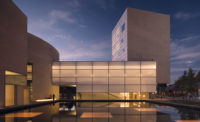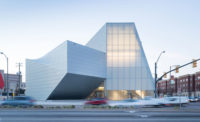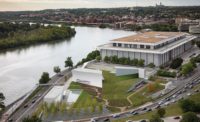Steven Holl frequently seeks ideas in the Architectonics of Music, and as a composer I consulted on the Lewis Arts Complex.
Visiting the finished building now, I see the ideas of Morton Feldman’s music everywhere in Steven’s magnificent realization—and not just in the rugs of the Music Building that reproduce the graphic notation of Feldman’s early works. Steven’s architecture embodies the spirit of Feldman’s expansive and mystical late works.
Although written in conventional notation and with great precision, Feldman’s late compositions direct attention away from the tick-tock that keeps most music earthbound. They likewise eschew amorphousness. Likewise Steven’s designs disdain both quotidian regularity and deliberate disorientation.
Feldman achieves a ‘tapestry of sound’ not only in the multi-layered terms of harmony, but also in the more profound sense as a totally integrating force of expanding self-referential relationships, weaving and knotting ever widening loops, through sequences with repetitions and near-repetitions. Each note always in relation to many others, and the group relation always clearly related to a larger perspective, and an even larger perspective in turn. By this musical alchemy every individual note gains an almost physical presence and sense of integrity as a participant in emergent patterns and then patterns-in-patterns, even with altered positioning in these patterns.
The Lewis Complex is an architectural analogue of this musical alchemy, with so many felicitous interactions of its components. Each constituent part of the complex has its own integrity, grown from the smallest elements outwards towards the larger patterns. Even when turned around in different paths, you always know where you are.
Many of the physical realizations are breathtaking. The Princetonians have already dubbed the largest of the dance studios the “cloud studio” because its translucent window wall transforms the sense of gravity—dancers enter already floating.
The practice rooms in the music building are both glorious and humorous: The need for acoustic and social isolation is visually expressed as many cherry-wood boxes of different sizes, all with windows allowing natural light and outside views while maintaining privacy, and all suspended within the building completely separated from each other. The boxes are visible through the window wall of the building—ready to be read from the outside almost like a musical notation itself.
It is striking too how much subtle reassurance and stress-reduction is built into the architecture through its interconnections. The skylights in the large, open-form “forum” space in between the component buildings don’t just provide light, for example. The skylights are under a reflecting pool in the welcoming public square above. So the breezes on the water gently ripple the light going down into the forum, alchemically transmuting light in motion that produces a calming, quiet beauty. How can this not be a transformative gathering place?
Raphael Mostel is a composer. The Berlin Philharmonic presented his “Travels of Babar” last season. For the past decade he has consulted for SHA on a number of projects and taught with Steven Holl in Holl’s “Architectonics of Music” Studio at Columbia University GSAPP.










Post a comment to this article
Report Abusive Comment